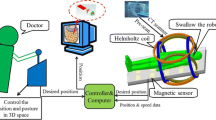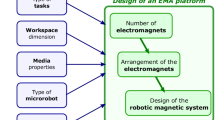Abstract
According to the feature of the magnetic actuation principle, now there are mainly three driving methods: one is alternating magnetic field, another is stationary gradient magnetic field and the last one is rotating magnetic field. This paper provides a detailed insight into the present-day state of microrobot technology and development on structure and electromagnetic actuation (EMA) systems. Firstly, the microrobot based on the three actuation methods is selectively elaborated respectively and the structure of EMA systems, microrobot characteristics and actuation principle are all analyzed and compared; finally some of the critical aspects of microrobot and EMA system design are considered. This paper shows that rotating magnetic field will be the most actuation promising method in the future biomedical application.
Access this chapter
Tax calculation will be finalised at checkout
Purchases are for personal use only
Preview
Unable to display preview. Download preview PDF.
Similar content being viewed by others
References
Sun, L.N., Liu, P.K., Wu, S.Q., Liu, T.: Status and development of in-pipe micro robot. Optics and Precision Engineering 11(4) (August 2003)
Song, X.F., Tan, S.L.: Development and Research State of Micro-robot at Home and Abroad. Machine Tool & Hydraulics (August 2004)
Cai, H.G.: Robot Will be a Hot Spot of Technological Development in the Twenty First Century. China Mechanical Engineering (2001)
Fu, G.Q., Mei, T., Kong, D.Y., Zhang, Y.: Status quo and future development of microrobot field driving technology. Optics and Precision Engineering 11(4) (August 2003)
Kim, S.H., Hashi, S., Ishiyama, K.: Magnetic Actuation Based Snake-Like Mechanism and Locomotion Driven by Rotating Magnetic Field. IEEE Transactions on Magnetics 47(10) (October 2011)
Byun, D., Choi, J., Cha, K., Park, J., Park, S.: Swimming microrobot actuated by two pairs of Helmholtz coils system. Mechatronics 21(1), 357–364 (2011)
Pan, Q.X., Guo, S.X.: A Paddling Type of Microrobot in Pipe. In: Proceedings of 2009 IEEE International Conference on Robotics and Automation (ICRA 2009), Kobe, Japan, pp. 2995–3000 (2009)
Choi, J., Choi, H., Cha, K., Park, J., Park, S.: Two-dimensional locomotive permanent magnet using electromagnetic actuation system with two pairs of stationary coils. In: 2009 IEEE International Conference on Robotics and Biomimetics (ROBIO 2009), pp. 1166–1171 (2009)
Choi, H., Choi, J., Jeong, S., Yu, C., Park, J., Park, S.: Two-dimensional locomotion of a microrobot with a novel stationary electromagnetic actuation system. Smart Materials and Structures 18(11) (2009)
Floyd, S., Pawashe, C., Sitti, M.: An untethered magnetically actuated micro-robot capable of motion on arbitrary surfaces. In: IEEE Int. Conf. on Robotics and Automation 2008, pp. 419–424 (2008)
Kim, S.H., Hashi, S., Ishiyama, K.: Magnetic Actuation Based Snake-Like Mechanism and Locomotion Driven by Rotating Magnetic Field. IEEE Transactions on Magnetics 47(10), 3244–3247 (2011)
Zhang, L., Abbott, J.J., Dong, L.X., Peyer, K.E., Kratochvil, B.E., Zhang, H.X., Bergeles, C., Nelson, B.J.: Characterizing the swimming properties of artificial bacterial flagella. Nano Letters 9(10), 3663–3667 (2009)
Zhang, L., Abbott, J.J., Dong, L.X., Kratochvil, B.E., Bell, D.J., Nelson, B.J.: Artificial bacterial flagella: fabrication and magnetic control. Appl. Phys. Lett. 94, 064107 (2009)
Author information
Authors and Affiliations
Editor information
Editors and Affiliations
Rights and permissions
Copyright information
© 2012 Springer-Verlag Berlin Heidelberg
About this paper
Cite this paper
Zhu, S., Hao, L., Wang, B., Li, Z., Dong, J. (2012). Structure and Electromagnetic Actuation Systems of Microrobot. In: Su, CY., Rakheja, S., Liu, H. (eds) Intelligent Robotics and Applications. ICIRA 2012. Lecture Notes in Computer Science(), vol 7507. Springer, Berlin, Heidelberg. https://doi.org/10.1007/978-3-642-33515-0_28
Download citation
DOI: https://doi.org/10.1007/978-3-642-33515-0_28
Publisher Name: Springer, Berlin, Heidelberg
Print ISBN: 978-3-642-33514-3
Online ISBN: 978-3-642-33515-0
eBook Packages: Computer ScienceComputer Science (R0)





